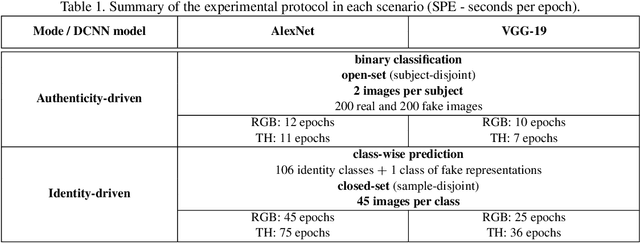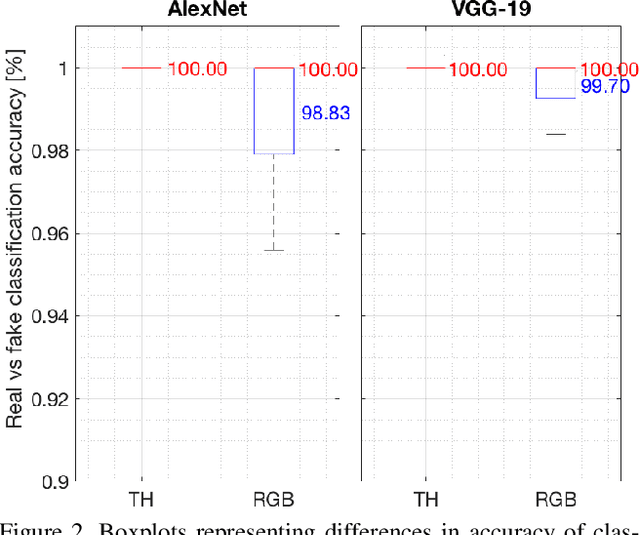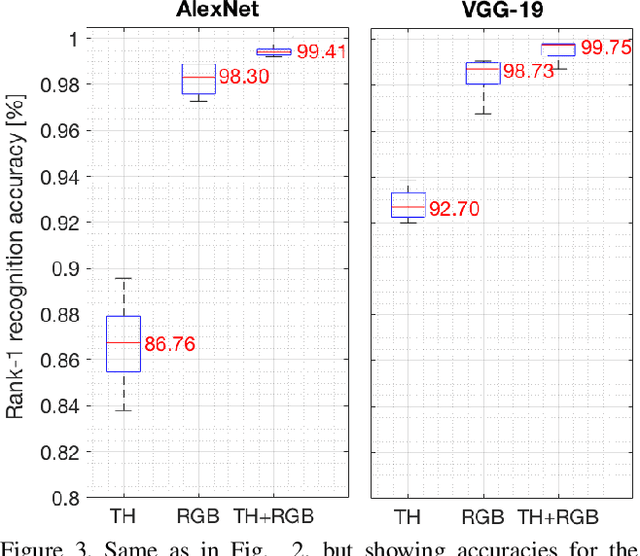Ewelina Bartuzi
Thermal Features for Presentation Attack Detection in Hand Biometrics
Sep 12, 2018



Abstract:This paper proposes a method for utilizing thermal features of the hand for the purpose of presentation attack detection (PAD) that can be employed in a hand biometrics system's pipeline. By envisaging two different operational modes of our system, and by employing a DCNN-based classifiers fine-tuned with a dataset of real and fake hand representations captured in both visible and ther- mal spectrum, we were able to bring two important deliverables. First, a PAD method operating in an open-set mode, capable of correctly discerning 100% of fake thermal samples, achieving Attack Presentation Classification Error Rate (APCER) and Bona-Fide Presentation Classification Error Rate (BPCER) equal to 0%, which can be easily implemented into any existing system as a separate component. Second, a hand biometrics system operating in a closed-set mode, that has PAD built right into the recognition pipeline, and operating simultaneously with the user-wise classification, achieving rank-1 recognition accuracy of up to 99.75%. We also show that thermal images of the human hand, in addition to liveness features they carry, can also improve classification accuracy of a biometric system, when coupled with visible light images. To follow the reproducibility guidelines and to stimulate further research in this area, we share the trained model weights, source codes, and a newly created dataset of fake hand representations with interested researchers.
MobiBits: Multimodal Mobile Biometric Database
Aug 31, 2018



Abstract:This paper presents a novel database comprising representations of five different biometric characteristics, collected in a mobile, unconstrained or semi-constrained setting with three different mobile devices, including characteristics previously unavailable in existing datasets, namely hand images, thermal hand images, and thermal face images, all acquired with a mobile, off-the-shelf device. In addition to this collection of data we perform an extensive set of experiments providing insight on benchmark recognition performance that can be achieved with these data, carried out with existing commercial and academic biometric solutions. This is the first known to us mobile biometric database introducing samples of biometric traits such as thermal hand images and thermal face images. We hope that this contribution will make a valuable addition to the already existing databases and enable new experiments and studies in the field of mobile authentication. The MobiBits database is made publicly available to the research community at no cost for non-commercial purposes.
Cross-spectral Iris Recognition for Mobile Applications using High-quality Color Images
Jul 11, 2018



Abstract:With the recent shift towards mobile computing, new challenges for biometric authentication appear on the horizon. This paper provides a comprehensive study of cross-spectral iris recognition in a scenario, in which high quality color images obtained with a mobile phone are used against enrollment images collected in typical, near-infrared setups. Grayscale conversion of the color images that employs selective RGB channel choice depending on the iris coloration is shown to improve the recognition accuracy for some combinations of eye colors and matching software, when compared to using the red channel only, with equal error rates driven down to as low as 2%. The authors are not aware of any other paper focusing on cross-spectral iris recognition is a scenario with near-infrared enrollment using a professional iris recognition setup and then a mobile-based verification employing color images.
 Add to Chrome
Add to Chrome Add to Firefox
Add to Firefox Add to Edge
Add to Edge